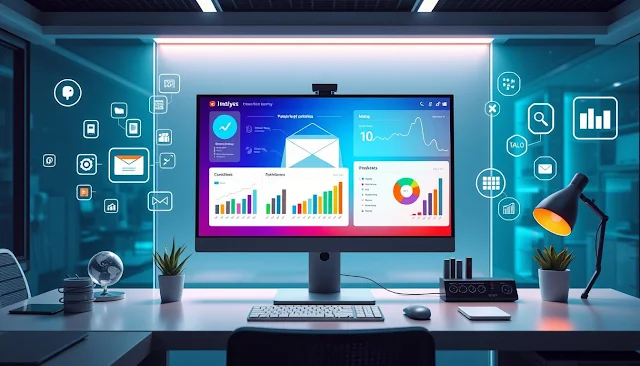Max wants to upgrade his company’s existing email software apex.

Max is eager to upgrade his company’s email system from Apex to a newer, more efficient platform. Effective email management is crucial in today’s business world, and Apex is starting to feel outdated, slowing productivity and causing frustration. Max isn’t alone; many businesses see the benefits of better email systems. This article will look at how the right email upgrade can improve internal and customer communication and boost overall efficiency.

Choosing the right email software can greatly impact a company’s communication and productivity. Max needs to understand Apex’s limitations before he can make a successful upgrade. Here are key areas where Apex might not meet the company’s needs.
Performance Problems: Ever hit “send” and nothing happens? Performance issues can be a major headache. Apex users report slow email dispatch, causing crucial communication delays and stress. Some settings even lead to service crashes, disrupting workflows. These issues turn routine tasks into frustrating obstacles.
Integration with Other Tools: Modern software should work smoothly with other systems. Apex struggles here, often leading to disconnected CRM, calendar, and email tools. The result? The outcome includes redundant tasks, overlooked opportunities, and inconsistent data. Finding an email platform that integrates well with project management and CRMs could be transformative for Max’s business.
User Experience: Let’s face it, no one likes clunky software. A user-friendly interface should make tasks easier, not harder. Many find Apex’s user experience outdated and confusing. It feels like navigating through a maze. A modern, easy-to-use interface can enhance workflow and employee satisfaction.
By focusing on these areas, Max can identify what his company needs in a new email solution, improving communication and team efficiency. Upgrading email software is crucial for enhancing productivity, security, and collaboration. Moving from Apex to a modern system can turn communication hurdles into successes.
Improved Speed and Performance: Imagine emails zipping through cyberspace to your inbox instantly. A new system speeds up email operations, cutting the sluggishness of older software like Apex. Faster processing reduces wait times and boosts productivity. Enhanced data management adds to overall communication speed and efficiency.
Better Security Features: Safeguarding data is crucial today. Modern email apps offer robust security against threats like phishing and malware. Advanced encryption and real-time threat detection help protect sensitive information while building trust. It’s like setting up top-notch security at home, monitoring every entry point.
Improved Integration: In business, synergy is key. Upgraded email systems integrate well with CRMs and other tools. Imagine automatically syncing emails with your CRM, streamlining workflows, and reducing errors. This connectivity ensures all parts work together, vital for business success.
Understanding these benefits helps Max see the potential of moving to a better email solution. By boosting performance, security, and integration, a new email system can greatly enhance the company’s communication setup.
Key Features to Consider in New Email Software: Choosing the right email software can transform company communication and operations. Max needs a solution that overcomes current issues and adds new features. Let’s examine the factors we should take into account for this upgrade.
Why Advanced Analytics Matter: Analytics help measure email impact. Tracking open rates and engagement gives insight into email campaign success.
Email Engagement: See how recipients interact with your emails.
– Conversion Rates: Learn how emails drive sales or desired actions.
Audience Segmentation: Tailor content based on user behavior.
Without analytics, understanding target achievement can be challenging. This feature turns insights into actions, letting Max improve strategies.
Why is a user-friendly interface crucial? Time is valuable, and no one wants to waste it on difficult systems. A smooth user experience lets employees navigate easily, reducing the need for extensive training.
– Clear Design: Easy navigation saves learning time.
Personalized Dashboard: Users can customize workspaces for better productivity.
Regular Updates: Ensure software evolves with user needs and tech advances.
Consider user-friendly software as a smooth highway; you reach your goals faster and with less hassle.
Support and Training Resources Matter: Excellent support and training are vital when adopting new software. Why is this important for Max? Effective support minimizes downtime and helps team members feel confident with the new system.
24/7 Customer Support: Quick problem-solving reduces interruptions.
Comprehensive Training Resources: Video tutorials, webinars, and manuals help users gain proficiency.
Community Forums: Spaces for users to share experiences and solutions.

Good support is like having a pit crew for your business’s race car, ensuring you stay on track without hitches. Effective support can make the transition to new software smooth and stress-free for everyone involved.
By focusing on these features, Max can decide on an email solution that meets current needs and positions the company for future growth and efficiency.
Comparing Leading Email Solutions: Navigating the email solutions market is like assembling the perfect project team. Each option has its pros and cons. How does Apex compare to major players like Microsoft Outlook and Gmail for Business?
Apex competes with heavyweights like Microsoft Outlook and Gmail for Business. So, where does Apex stand?
Microsoft Outlook: Known for enterprise features and seamless integration with Microsoft’s ecosystem, it’s a favorite for large organizations. It offers robust calendar and task management tools essential for productivity.
Gmail for Business (Google Workspace) stands out with its intuitive interface and collaboration tools like Google Meet and Drive. It’s excellent for clear and effective communication.
Apex provides basic email functions, but it lacks advanced integration and a user-friendly experience. Suitable for smaller teams, it may fall short compared to Outlook’s enterprise focus or Gmail’s streamlined experience.
Cost Comparison: Cost considerations extend beyond the initial purchase, encompassing hidden fees and maintenance costs that can accumulate over time.
Office 365 bundles Outlook, with plans from $5 to $20 per user monthly. While initially appealing, costs can rise with extra features. Gmail for Business offers straightforward pricing from $6 to $18 per user monthly, ideal for growing teams needing scalable options. Apex might seem cost-effective at first, but technical support or integrations could add unexpected costs. Consider potential hidden charges if the solution lacks flexibility.
User Reviews and Satisfaction: User reviews reflect software’s practical use and reliability.
Microsoft Outlook is praised for its features, but new users may find it complex. Large firms value their capabilities despite a steeper learning curve.
Gmail for Business is renowned for its user-friendly interface and collaboration features. Users often express satisfaction, citing its dependability and ease of use.
Apex: Users highlight limitations in user experience and accessibility. While it meets basic needs, the lack of advanced features and modern design is a drawback compared to more user-friendly alternatives.
Choosing an email solution involves more than checking a box; it means finding what truly fits your business needs. Whether you’re considering big names or exploring lesser-known options like Apex, the key is matching your needs with the right features and costs.
Steps for Implementing New Email Software: Switching to new email software can be a big task, but following the right steps makes it easier. Moving from Apex involves stages like evaluation and training. Here’s how to do it effectively.
Assessment and Selection: Choosing the right email software lays the foundation for your communication needs. For Max to make a smart choice, he should thoroughly assess potential solutions.
Identify Requirements: List what’s lacking in the current system and what essential features are needed.
Research Options: Look for reviews and comparisons that highlight strengths and weaknesses.
Consider Costs and Benefits: Look beyond initial costs to potential savings or productivity boosts. Spending more upfront can lead to better efficiency.
Test the Software: Trials let you see if the software fits your business operations.
Gather Team Feedback: Input from daily users helps predict adaptability.
Migration Plan: A well-planned migration prevents disruptions. Here’s a structured overview:
Create a timeline: Set milestones like data backup and cutover dates to ensure a smooth transition.
Back Up Data: Secure all emails and contacts before moving. Safe data storage gives peace of mind.
– Choose a Migration Method: Options like staged or hybrid migrations have pros and cons.
– Pilot Test: A limited test group helps spot issues before full implementation.
Monitor Transfer: Ensure emails and settings transfer accurately.
Training and Support for Staff: Once new software is live, train the staff. Max’s plan ensures everyone stays on track.
Hold training sessions: Use workshops or webinars to familiarize users with new features.
– Develop learning materials: Provide easy guides and FAQs. Accessible resources enable staff to solve minor issues.
Set Up Support Channels: Ensure help is available via chat, email, or phone for urgent concerns.
Collect Feedback: Post-training feedback helps pinpoint areas needing more focus.
Update Training Material: Keep updating materials with software change.
By following these steps, Max can navigate the complexities of upgrading his company’s email software. A structured approach ensures a smoother transition and keeps the team happy.
Switching from Apex can lay the foundation for better business communication. A modern email system boosts productivity by working faster and integrating smoothly with current tools. Email security gets a boost, with advanced defenses against cyber threats. It’s like wrapping your data in strong protection.
Changing tools isn’t just an adjustment; it’s a move toward a more flexible work environment. Improved efficiency and user experience lead to happier teams. When tech issues don’t hinder employees, they can concentrate on the important task of expanding the business.
Ready to make the leap? Exploring new email solutions is more than an upgrade; it’s a commitment to a more efficient future. Equip your team with the tools to excel and watch everything fall into place. What’s holding you back? Make that change today!

In today’s work environment, the tools we use significantly impact success. Adopting a more advanced system is about nurturing a culture of efficiency, collaboration, and innovation. Providing the right resources lets employees maximize their potential, improve workflows, and contribute more to the organization. This boosts productivity and enhances employee satisfaction and engagement.
Imagine a workplace with effective communication, effortless project management, and ample room for creativity. Upgrading systems offers a real chance to create this environment. It encourages teamwork and removes barriers that often hinder progress. Everyone can take charge, work together in real time, and share insights that drive projects forward. The result is a collaborative space where everyone feels valued and motivated to excel.
Yet, with all these benefits, one question remains: Why not embrace this change? Sticking to the familiar might mean missing the chance to improve teams and organizations. While adopting a new system may seem daunting, the benefits outweigh the temporary discomfort. Don’t let fear or uncertainty dictate your choices; take a step toward change and encourage your team to embrace the future.
Now is the time for transformation. By adopting advanced tools and systems, you’re not just upgrading; you’re shaping your organization’s future. Seize the opportunity to lift your team, boost collaboration, and streamline processes. Make that change now and see your team thrive in an environment that promotes success and innovation.